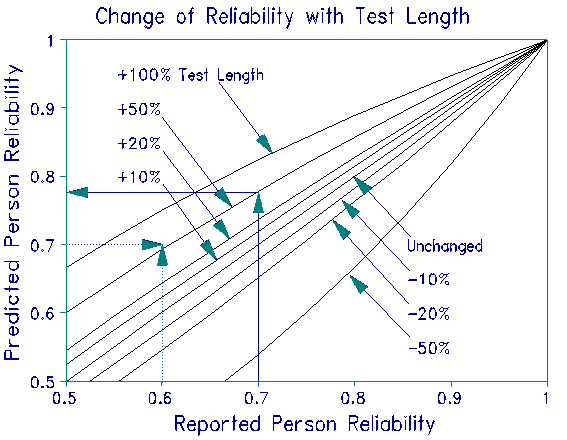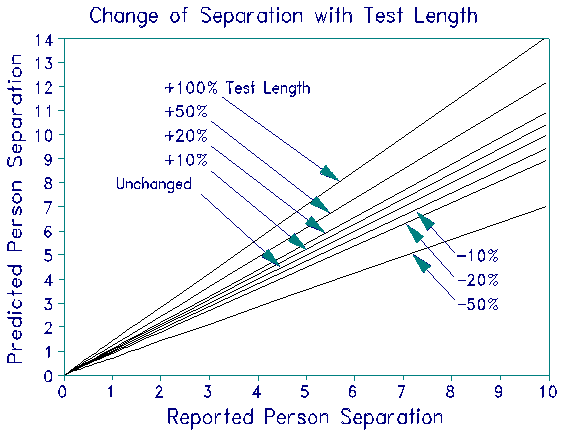
"What would be the effect on test reliability of shortening or lengthening my test?" These nomograms predict the reliability and person separation for tests of different lengths administered to the same sample, with other item and person characteristics held constant. Reliability has its usual (KR-20, Cronbach alpha) definition of "true" person measure variance divided by observed person measure variance. Person separation is defined as "true" person measure standard deviation divided by person measure precision (standard error).
Suppose the reported reliability of your pilot test of 100 items is 0.7. What would be the effect of adding 50 items, i.e., increasing the test length by 50%?
Answer: On the reliability nomogram), find the reported reliability of 0.7 on the X-axis. Go vertically upwards till you meet the +50% curve (see solid arrow), then go across to the Y-axis to discover the predicted reliability of almost 0.8.

Suppose reported reliability is 0.6, but you want at least 0.7. How many items must you add?
Answer: Read up vertically from the reported reliability of 0.6 (dotted arrow). Read across horizontally from the predicted reliability of 0.7 (dotted arrow). The arrows meet just above the +50% curve. To achieve the desired reliability, more than 50% extra items must be added to the test. The separation nomogram (in printed text) works the same way.

Reliability and separation nomograms. Linacre JM. … Rasch Measurement Transactions, 1995, 9:2 p.421
| Forum | Rasch Measurement Forum to discuss any Rasch-related topic |
Go to Top of Page
Go to index of all Rasch Measurement Transactions
AERA members: Join the Rasch Measurement SIG and receive the printed version of RMT
Some back issues of RMT are available as bound volumes
Subscribe to Journal of Applied Measurement
Go to Institute for Objective Measurement Home Page. The Rasch Measurement SIG (AERA) thanks the Institute for Objective Measurement for inviting the publication of Rasch Measurement Transactions on the Institute's website, www.rasch.org.
| Coming Rasch-related Events | |
|---|---|
| Jan. 16 - Feb. 13, 2025, Fri.-Fri. | On-line workshop: Rasch Measurement - Core Topics (E. Smith, Winsteps), www.statistics.com |
| Apr. 8 - Apr. 11, 2026, Wed.-Sat. | National Council for Measurement in Education - Los Angeles, CA, ncme.org/events/2026-annual-meeting |
| Apr. 8 - Apr. 12, 2026, Wed.-Sun. | American Educational Research Association - Los Angeles, CA, www.aera.net/AERA2026 |
| May. 15 - June 12, 2026, Fri.-Fri. | On-line workshop: Rasch Measurement - Core Topics (E. Smith, Winsteps), www.statistics.com |
| June 19 - July 25, 2026, Fri.-Sat. | On-line workshop: Rasch Measurement - Further Topics (E. Smith, Winsteps), www.statistics.com |
The URL of this page is www.rasch.org/rmt/rmt92a.htm
Website: www.rasch.org/rmt/contents.htm